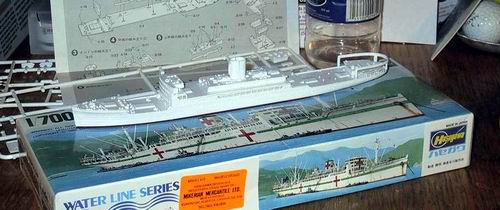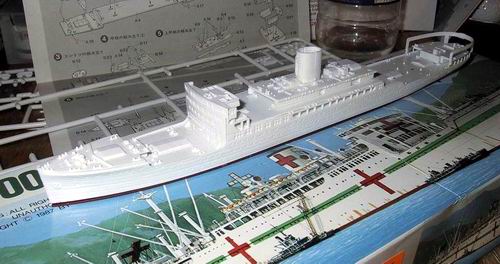
HAZEGAWA’s Hospital Ship HIKAWAMARU / Submarine Depot Ship HEIANMARU
HIKAWAMARU:
Scale / Size: 1:700 (length 23 cm, width 3 cm)
Kit Number: No. 90 WATER LINE SERIES
Review by Arjay / Photos by Mike Cook

Dry-stacked. Note protective ‘guard’ at the stern (to be removed).
One must give Hasegawa credit for realizing the full potential of a resource. From one mold the company has issued three kits: The HIKAWAMARU as a passenger liner, as a hospital ship (the subject of this review), and the HEIANMARU, a passenger liner of the same design converted into an IJN submarine depot ship during WW2. Where separate decal sheets could have sufficed (and an extra sprue for the ‘Heian’, gun platforms and the like), Hasegawa packaged these as separate offerings. Three times the punch for, relatively speaking, one-time R/D investment. Smart thinking.
I was unaware this kit still existed until stumbling across it in a modest model shop during a recent business trip. I must confess, I am somewhat less knowledgeable of liners that served routes other than the North Atlantic, yet was familiar with this particular vessel via Atle Ellefsen’s excellent rendering of her in civilian livery. I must also confess a particular favoritism of cargo-liners, and hospital ships in general, resulting from my familiarization with British India’s UGANDA, on which I sailed in 1975. A 1952 cargo-liner of similar size and general arrangement, UGANDA was converted into an educational school ship in 1968 and served Her Majesty’s Government honorably as a hospital ship, and later trooper, during the 1982 Falkland’s War. I digress…..
This commentary can be viewed as supplementary to Thomas Richter’s excellent review, previously posted. Thus I will not, for the sake of brevity, repeat the accounting of the ship’s history and an itemized list of kit parts and instructions other than highlighting the features I believe to be noteworthy. Such as:
With exception of the separate bottom piece, molded a semi-transparent ‘cherry red’, all other components are white. In my opinion this is preferable to the ‘black hull / lower superstructure’ of the civilian liner offering. From my experience, painting ‘black over white’ is much easier than ‘white over black’. A flat steel bar is provided, ballast of sorts, for the lower hull piece.
Molded detail is 2nd to none. This has to be one of the best I’ve seen in terms of crispness, in the same league as Revell’s 1:1200 AIDA. Although hull strakes are somewhat exaggerated, (When are they not? Model companies would be wise to either ignore them, or simply scribe the hull to represent hull plates.); the attention to detail, especially on components that will be screened from view and thus secondary in importance (the underside of most deck components feature structural elements), is a welcome change from what we have more-or-less accepted as being the industry norm. Flash is minimal. If this kit is any indication, I can only imagine the detailed liner Hasegawa could produce at 1:600 or 1:350 scale. The only disappointment (minor) is the forward superstructure. Open voids (on the real ship) are molded solid, although recessed. One could attempt to open these, yet the resulting ‘scale thickness’ would be off. Painting these voids ‘flat black’ should suffice, as Atle has done.
Decals: Red crosses / green stripes and ship identification is provided. Unfortunately, no flags.
Ease of Conversion: This kit could easily be rendered to represent her civilian role. The only issue will be the lack of appropriate decals.
Ease of Construction: Superb tooling / molding results in an excellent fit of most parts. Crack filling will not be a serious issue. However, considering the scale and the clutter of raised deck equipment, painting may be a challenge given the masking involved. I would rate this model a ‘three’, based on AirFix’s rating of 1 – 4 (easy to most difficult).
Detailing: As molded railings are not featured this kit will easily accept 1:700 P/E railings, and associated components, as evident by Atle’s building. The complex rigging, given the scale, could be an issue yet manageable to those more experienced.
Quality of Product: Hasagawa’s attention to quality is much appreciated. Both the one-piece hull and detachable bottom are molded with protected ‘cages’ to prevent delicate detail from being damaged or snapped off during handling and transit. If only all manufacturers would pay the same attention, and concern, to the condition of their product at the point of sale. Given the distance it has traveled it is remarkable not one piece was damaged or knocked off its sprue.
Issues: Only one. As can be expected the assembly instructions, although exceptionally detailed and easy to follow, are printed in Japanese only. English translation, with respect to paint colors, would have been appreciated although the box-art gives a fair representation, save for deck equipment, hatches and the like.
Rating: Based on dry stacking alone (I have yet to assemble), I give this kit an overall score of 9.5 out of 10, the highest I’d give any kit as no kit is perfect. Although it may not be a common item on most hobby store shelves, I have seen it listed (and her civilian version as well, which I have recently acquired) on at least one hobby web-site: www.tridenthobbies.com

Note the open promenade: the inner bulkheads behind are detailed
even though they will be difficult to see.
HEIANMARU:
Scale / Size: 1:700 (length 23 cm, width 3 cm)
Kit Number: No. 522 WATER LINE SERIES
Produced from the same molds as the hospital ship HIKAWAMARU, my previous comments equally apply to this fine kit, with the exceptions as noted:
All parts, including the detachable flat bottom (no cherry-red this time) are molded dark gray, including the decks. I personally would have preferred white as the scribed decking (depending on the type of paint used, and application) may require multiple coats. Given the abundance of molded deck detail this may be an issue. The steel ‘ballast bar’ was not included in this kit, either by design or oversight.
Two additional sprues featuring circular gun platforms, guns and extra launches are included. Additional holes are required to be opened-up to accommodate the extra pieces, the locations clearly identified by the instructions. On one piece molded equipment needs to be removed to install one of the gun platforms, also identified by the instructions.
Instructions, thankfully, are presented in both Japanese and English; thus paint references are not as elusive as with the HIKAWAMARU. Paint schemes are illustrated for two ships of the same design: the HEIANMARU and the HIEMARU. Where the HIEMARU was painted a uniform dark gray the HEIANMARU was dazzle-painted, something I am eager to attempt. Photo-enlarging the smaller scale profiles (both sides, and top view, are illustrated) to equal the model’s 1:700 scale will be of benefit. It is interesting to note that the instructions state: Modeling skills helpful if under 10 years of age….. somewhat of an understatement in my opinion!
Decals are an improvement over those offered with the HIKAWAMARU, featuring flags and identification for both the ‘HEIAN’ and ‘HIE’ options. I am surprised Hasegawa did not offer the ‘HIEMARU‘ as a separate kit.
Rating: As with the ‘HIKAWA’ I give this kit an overall rating of 9.5 out of 10. Again, although not commonly found on most hobby store shelves it is offered by several hobby web-sites. I acquired mine from www.greathobbies.com (Canadian site), yet is also available at www.tridenthobbies.com, an American site.
Summary Comments: Both kits, and the HIKAWAMARU in civilian livery (one I have recently acquired), are worth obtaining. Although not in the same class as the heavyweights of the North Atlantic they were, as designed and built, liners / merchant ships. And, as we are only too well aware, manufacturers are not producing many new subjects these days. I am now of the mindset: when available, purchase ….. Happy Modeling!
Arjay ~ 09/03